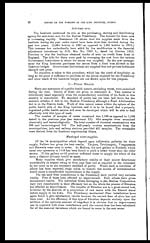Medicine - Institutions > Reports from medical colleges, schools and research institutions > Report of the King Institute of Preventive Medicine, Guindy > Reports on the working of the King Institute of Preventive Medicine, Guindy for the official year 1921-22 and the Micro-biological Section for the period from 1st January to 31st March 1921
(27) Page 17
Download files
Individual page:
Thumbnail gallery: Grid view | List view

REPORT ON THE WORKING OF THE KING INSTITUTE, GUINDY
17
The water supplies to the three hill stations, derived from lakes and
reservoirs have as usual yielded satisfactory results.
The supplies from wells and springs have been very variable.
Jails.
With the possible exception of Tanjore Jail the remainder, nine in number,
have been, as usual, very unsatisfactory. The need for systematic sterilization
by chemicals or boiling has been apparent in the case of every one of these supplies.
Salem, Berhampore, Vellore and Tanjore have a possible alternative. At all
these places a municipal supply exists which is better than that of the jail.
These jails could thus improve their position considerably if they took advantage
of the municipal supply.
Railway stations.
The water supplies of the stations on the Madras and Southern Mahratta
system which have been examined are now with few exceptions in a satisfactory
condition. Those on the South Indian Railway are not so good. Of the three
stations on the Bengal-Nagpur Railway the supply to Naupada, in spite of the
improvements suggested and carried out, is still far below the standard required
for safety.
The possibility of a fresh source of supply should therefore be considered.
The Railway authorities have, as a rule, evinced the greatest interest in the water
supplies of their stations and have been anxious to take the steps suggested by
this Institute for the improvement of their supplies. A summary of the results
of the examinations of the individual water supplies will be found in Appendix I.
IV.—ASSISTANCE TO OTHER DEPARTMENTS.
1. The regulations issued in connexion with the visit of His Royal Highness
the Prince of Wales to Madras caused a considerable increase in the work of the
King Institute. This work consisted of a systematic search for dysentery and
enteric "carriers" amongst the staff of all those who had the honour of enter-
taining His Royal Highness. Three hundred stools were examined and cysts of
E. hystolitica were found in 4 cases. The removal of those individuals from
duties involving close association with food was recommended. T.A.B. and
cholera vaccines were also supplied for inoculation.
The milk and water supplies were also systematically examined, twenty-two
samples of milk and 19 samples of water being tested in this way. Assistance and
advice as to the efficient sterilization of both milk and water was given and, both
apparatus and staff were lent for the purpose.
2. It was felt that the efficient working of the Madras Water Works at,
Kilpauk required a separate laboratory at the site of the works and the services
of a specially trained Water Analyst. At the request of the Commissioner of the
Corporation, the Director of the King Institute supplied the Special Engineer of
the Corporation with a detailed plan of a suitable laboratory and also lists and
estimates of the necessary equipment. The Director also interviewed and advised
the Commissioner as to the selection of the most suitable candidate for the
Analyst's post.
3. In February 1922 at the request of the Surgeon-General the Director
visited the Camp Jail for Mappilla prisoners at Bellary. The sick rate at this jail
was causing some anxiety. The Director was ordered to forward a report as to
its cause and the preventive measures which should be taken. This report was
forwarded with my letter R.O.C. N o. 950-12-B, dated 25th March 1922.
The chief causes of mortality were found to be dysentery, chicken-pox,
cerebrospinal fever and influenza. Advice as to the prevention and further
spread of these diseases was given on the spot and it was also recommended that
a bacteriological laboratory should be sent from the King Institute to work in the
jail. This laboratory was despatched, immediately the Director returned to the
Institute, on the orders of the Surgeon-General, and was at work at Bellary within
5
Set display mode to: Large image | Zoom image | Transcription
Images and transcriptions on this page, including medium image downloads, may be used under the Creative Commons Attribution 4.0 International Licence unless otherwise stated. ![]()
| Permanent URL | https://digital.nls.uk/74936408 |
|---|
| Description | 13 titles. Describes research work and conditions, treatments, vaccine production, medical education, public health and disease outbreaks. Extensive tables show mortality rates and patient admissions. These - some from asylums, jails, dispensaries, civil and police hospitals – will be useful to epidemiologists. |
|---|




